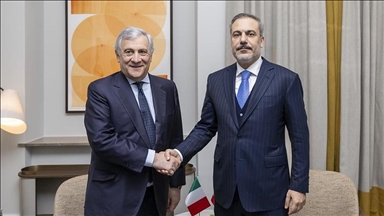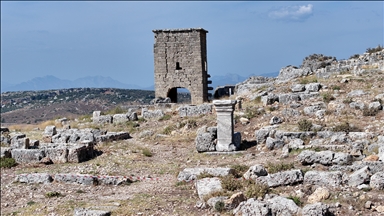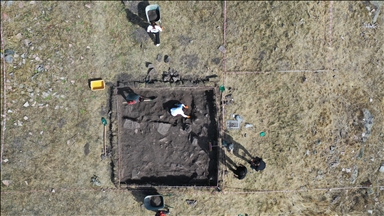FEATURE - Tomb of Roman philanthropist in Turkish Mediterranean city sheds light on past
Menodora ranks among wealthiest, most philanthropic elites of ancient Mediterranean

- Ongoing excavations around tomb expected to reveal new insights into burial customs of city’s elite in Roman era
ANTALYA / ISTANBUL
In the ancient city of Sillyon in Antalya on the Turkish Riviera, archaeologists have uncovered the tomb of Menodora, known from historical records for financing the construction of many buildings in the city and for founding a charity for children.
A team of nearly 50 people led by Murat Taskiran, an archaeologist at Türkiye's Pamukkale University, is carrying out the excavations. The project is being conducted under the Turkish Culture and Tourism Ministry’s Heritage for the Future initiative, with the Turkish petroleum company Opet as the main sponsor.
During the work carried out on the city’s main street, a tomb was uncovered along the roadside. Its placement in a special area drew the attention of the excavation team. Further study revealed that the tomb belonged to Menodora, a Roman woman philanthropist who lived in the city in the second century A.D.
The ongoing work around the tomb is expected to shed light on the burial traditions of the city’s elite during the Roman era.
Speaking to Anadolu, excavation leader Taskiran said that this year, they plan to focus their work on the main street stretching from the city’s entrance to the hilltop known as the acropolis, noting that about a 1-kilometer (0.6-mile) section has already been uncovered.
Inscription reveals Menodora’s philanthropy
Taskiran also noted that a 26-line inscription, previously identified and transcribed, was unearthed at the site, providing a summary of the donations and construction work carried out by Menodora and her family for the city.
"By analyzing the inscription, which had previously been transcribed, with different techniques, we have uncovered new details. We have now identified Menodora’s tomb in broad outline. The inscription found near the tomb was erected in its proper place following the recent work," he said.
"The next step is to carry out landscaping around the tomb to make the site more visible. Our work will continue so that visitors can better visualize ancient burial architecture, particularly how the tombs of the elite were built.”
He emphasized that philanthropy was a highly important institution in the Roman era, with Menodora serving as a striking example as one of the wealthiest and most philanthropic women of the ancient Mediterranean.
Behind her philanthropy lies a tragic story
Taskiran said that it is known that Menodora had an "unfortunate fate."
"She lost her father Megakles at an early age. Later, her husband Apollonios died, and not long after, her son also passed away. She was truly a woman marked by grief. Yet she put her sorrows aside and used the wealth and power inherited from her family for Sillyon, devoting the rest of her life to the revival of the city," he said.
He noted that inscriptions and other archaeological evidence show that Menodora held a position comparable to today’s city council chair, managed the gymnasium, and founded a charity for children.
Most lavish-spending benefactor of ancient world
Highlighting that the benefactor placed particular importance on children’s education, Taskiran said records also show she commissioned monumental buildings and temples.
"We also know that the bathhouse and the stadium date back to her time. Menodora demonstrates how a city could be revitalized through the hands of a woman," he added.
He underscored that Menodora stood out as a different kind of figure from the usual concept of philanthropy.
"We know that many cities had benefactors, such as Plancia Magna.
"What makes Menodora unique is that she put all her sorrows aside and devoted herself entirely to her homeland. She spent her entire fortune on philanthropy, which experts estimate at 300,000 denarii in silver. This makes it possible to describe Menodora as the most lavish-spending benefactor of the ancient world," he noted.
Taskiran added: "She transformed Sillyon, with its difficult and rugged terrain, into a well-organized Mediterranean city, shaping it step by step. In other words, beyond being a philanthropist, she was also a visionary and an urban planner."
Anadolu Agency website contains only a portion of the news stories offered to subscribers in the AA News Broadcasting System (HAS), and in summarized form. Please contact us for subscription options.







